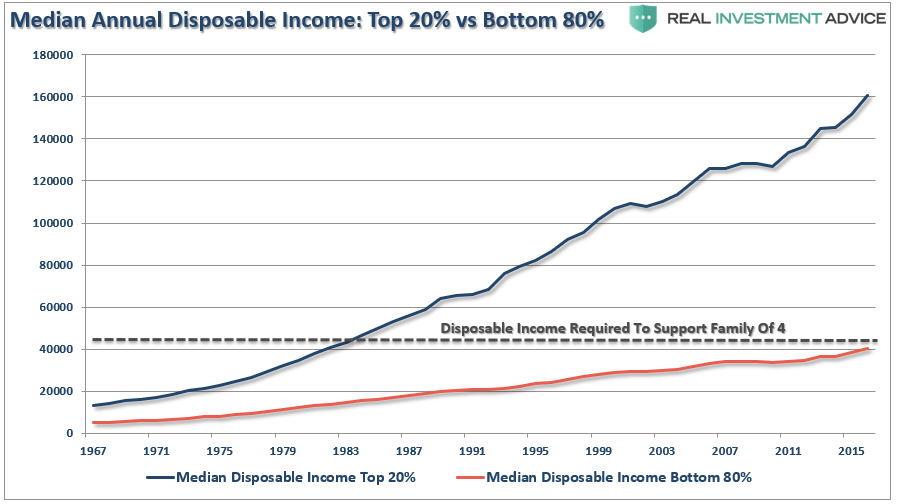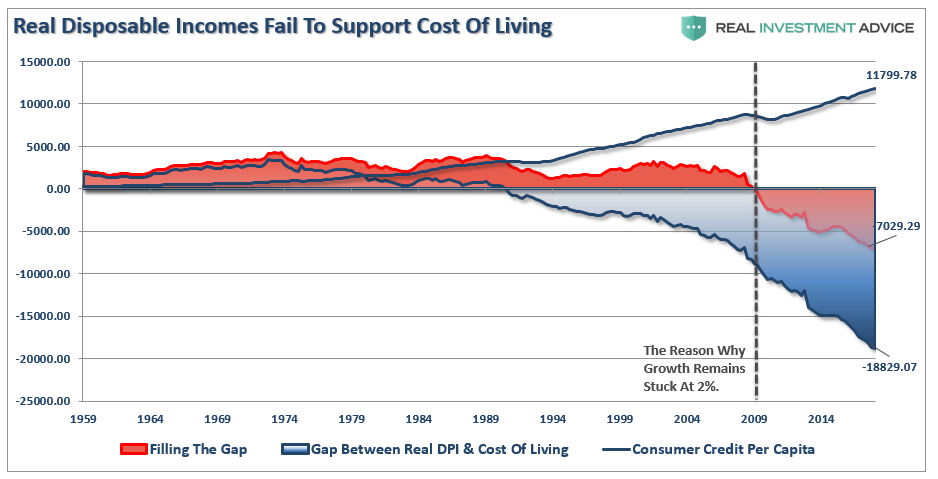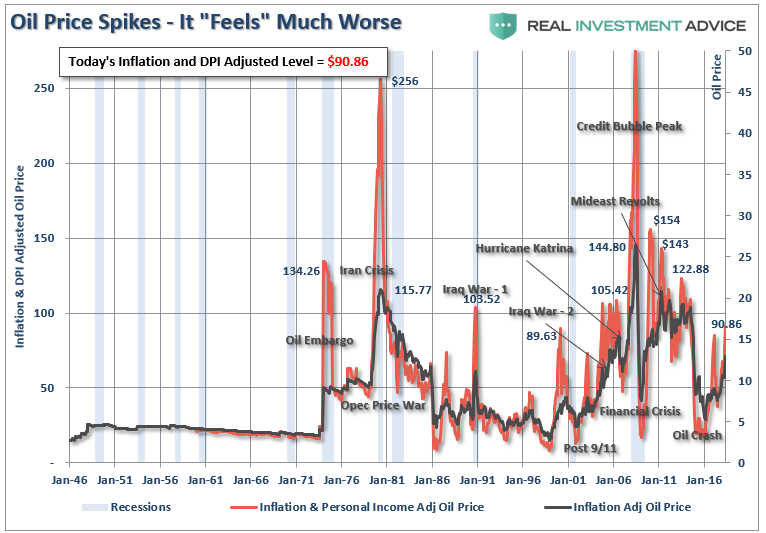Today, more now than ever, we are barraged with economic data of which most is lost on the average person. One data point, however, that everyone understands is the price of oil as it directly impacts the average American where it counts the most, in the “wallet.”
The price of oil is plastered just about everywhere from a litany of daily articles to Government policies, the Internet and, ultimately, at every gas station you drive by. Oil prices affect us every day in more ways than just what we are paying for a gallon of gasoline. It affects the cost of just about everything we wear, consume, or utilize, from hard products to services due to rising input costs, fuel surcharges, etc.
This is one reason when the government reports the consumer price index (CPI), and then strips out food and energy to report the core inflation index, it almost always elicits a negative response. Back in 2011, then Fed President William Dudley got a street-corner education in the cost of living when he tried to sell the Fed’s monetary policy to “average Americans.” Dudley tried to explain that while some commodity prices are rising, other prices are falling.
Today you can buy an iPad2 that costs the same as an iPad 1 that is twice as powerful, you have to look at the prices of all things.
What he is addressing here is called “hedonics”. Antony P. Mueller wrote a great piece on the “Illusions Of Hedonics” stating that:
The Bureau of Labor Statistics (BLS) applies “hedonics” when calculating the price indices and for the computation of the real gross domestic product and of productivity. The idea behind hedonics is to incorporate quality changes into prices. This way, a product may be on the market at a higher price, but when the product qualities have augmented more than the price in the eyes of the BLS, it will calculate that the price of this product has actually fallen.
Applying the hedonic technique to a host of goods and services means that even when prices were generally rising, but product improvement are deemed to be larger than the price increases, the calculated inflation rate will fall. With a lower inflation rate, the transformation of nominal gross domestic product (GDP) into real GDP will render a higher result. Likewise, given a constant labor input, productivity will increase. Hedonics opens the door to producing magical results: a lower inflation rate with generally rising prices, a higher growth rate although the economy may be weaker, and a higher productivity number, although productivity would have been declining without the hedonic imputations.
It is important to understand this concept as it is why Bill Dudley was immediately lambasted by reporters in the audience following his iPad statement with;
I can’t eat an iPad” and “When was the last time YOU went to a grocery store?
The reason the “average American” can’t grasp things like “hedonic” adjustments to the inflation index, or even the idea of stripping out volatile food and energy components of CPI to get a core index, is because they live in a world where their daily lives are affixed to the disposable personal income they bring home. The average American gets a paycheck and then must pay not only for rent, utilities, and health insurance, but also food and gas. In their mind why should you exclude the two items that are currently consuming roughly one-fifth of their wages and salaries?
While there has been a lot of pandering from the talking heads about rising oil prices, but what is more important to note is how these price increases in oil “feel” to the average American. The thing that the Fed and most economists miss, in my opinion, is that the average “American” is dealing with a lot of rising cost pressures that aren’t necessarily included in the inflation calculation. Furthermore, while prices of things like oil, commodities, college costs, insurance, healthcare, etc. have been rising; disposable personal incomes have grown at a much slower rates as shown below.

But even that measure of disposable personal incomes in deceiving because the top 20% of wage earners overly skew the data versus the bottom 80%. For the bottom 80% of income earners, disposable incomes are actually more disappointing.

Therefore, even small price increases have a more dramatic effect on the limited amount of disposable personal incomes available to the consumers in the bottom 80%. For many individuals today, the effects of the “financial crisis” have yet to fade as they are still unable to meet the required costs for their standard of living.
United Way has done a study on a group of Americans they call ALICE: Asset Limited, Income Constrained, Employed. The study found that this group does not make the money needed “to survive in the modern economy.” Between families living below the poverty line due to unemployment or disability, and ALICE, the study discovered that 43% of Americans were struggling to cover basic necessities like rent and food.
But even for those who are making ends meet, they aren’t saving either. Northwestern Mutual’s 2018 Planning & Progress Study, which surveyed 2,003 adults, found that 21% of Americans have nothing saved at all for their golden years, and a third of Americans have less than $5,000. To put that into perspective, it means that 31% of U.S. adults could last only a few months on their savings if they had to retire tomorrow.
That data supports the chart below which shows the gap between the inflation-adjusted median standard-of-living versus the disposable income and credit required to pay for it. Beginning in 2007, even after all the disposable income had been spent and credit cards maxed out, there is a growing deficit (currently over $7000) to support the living standard. This is why more individuals than ever are working multiple jobs, not retiring, or just curtailing spending.

Only So Much To Go Around
Of course, when the consumer is under pressure at home, they eventually must reduce consumption. The chart below shows inflation-adjusted oil prices as compared to inflation-adjusted disposable personal income and oil prices. Since oil prices are a direct input cost to so many different aspects of the daily lives of the average “American,” price spikes in oil have a very real impact on the way that consumers “feel” about their ability to make ends meet.

What we find is that when oil prices spike there is an immediate shock to the disposable personal incomes for individuals. For example, during the Iran crisis oil peaked at $109 per barrel, but for consumers it “felt” like $242 a barrel. Then at the peak of the oil market in 2008, when oil traded for $138 a barrel, it felt much closer to $258 as real disposable incomes had declined. Today, as oil trades around $71 a barrel, consumers “feel” like it is closer to $90.

This psychological “cost pressure” obviously impacts the way that consumers behave with their money. While the government tries to massage the differences in inflationary pressures to suppress adjustments to Social Security and Medicare; the average American is rapidly coming to grips with reality.
At some point the process of kicking the can down the road will meet its inevitable conclusion in this game of chicken as consumers continue to leverage themselves to extremes and neglect to save in order to support their standard of living. The evidence is clear that Keynesian economics is a failure, not just recently, but over the last 40-years as increased monetary supply, and lower interest rates, have led to declining wages, savings and the dollar which in turn induced malinvestment.

The declines in income, which have been covered up by increased household leverage as shown above, leaves little true disposable income with which to absorb higher costs from health care, energy, rent and food costs.
At some point, the Fed may well witness another type of deflation, but this time it won’t be just falling prices. Rather, it will be from the masses struggling to maintain a shrinking standard of living as the change shrinks from “Let Them Eat iPads” to just “Eat This!”
